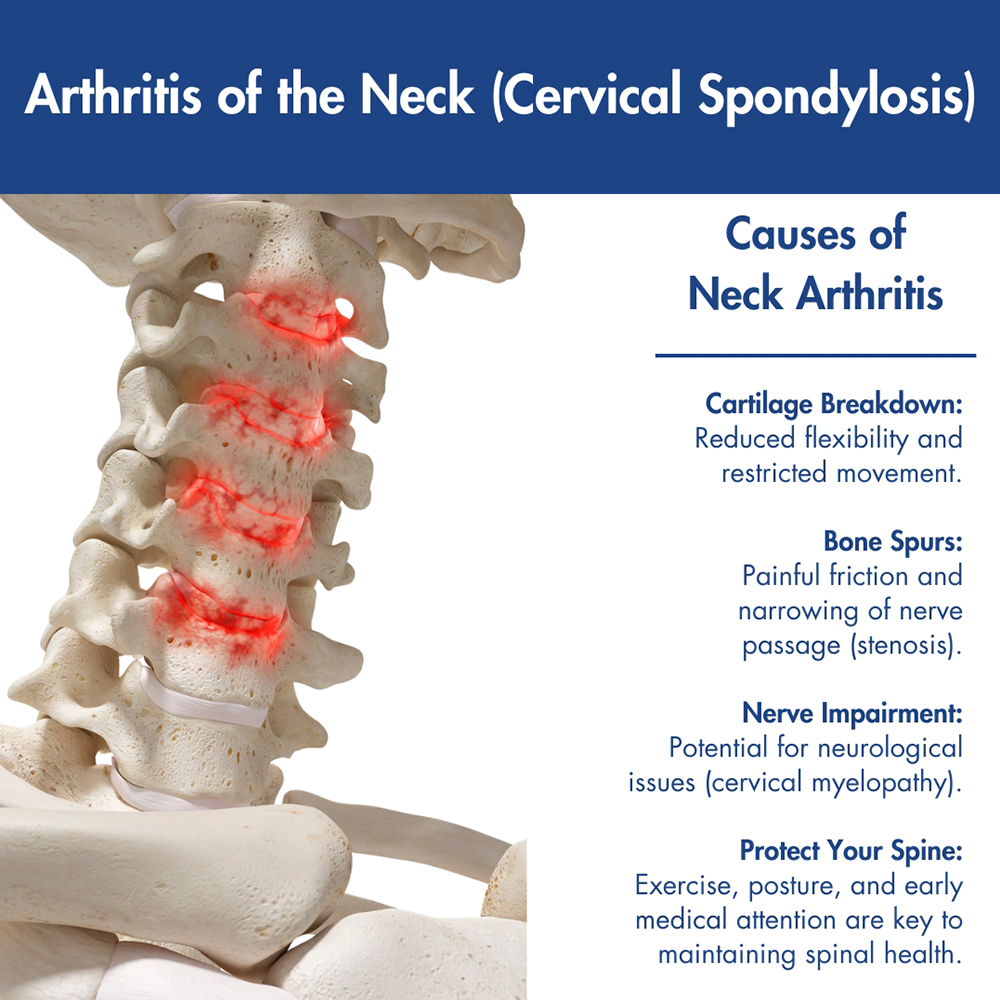We’re pleased to announce that Pain Physicians of Wisconsin is now Pro Spine Pain.
We’re pleased to announce that Pain Physicians of Wisconsin is now Pro Spine Pain.
 The long-standing strain on the bones of the neck serves as a precursor to arthritis, a condition commonly associated with aging and the cumulative effects of years of stress on the neck muscles and skeletal structure. However, no types of arthritis are exclusive to the elderly; anyone who wears down the protective cushions between neck bones is susceptible. Moreover, repetitive movements during early adulthood can hasten the onset of neck arthritis. Detecting the early signs and promptly seeking intervention can mitigate neck pain, offering relief and improved quality of life. For personalized guidance and support, reach out to Pro Spine & Pain to schedule a consultation. With our extensive expertise in supporting the people of Wisconsin, we are a trusted pain management center ready to assist you with neck arthritis or any other painful condition you may be experiencing.
The long-standing strain on the bones of the neck serves as a precursor to arthritis, a condition commonly associated with aging and the cumulative effects of years of stress on the neck muscles and skeletal structure. However, no types of arthritis are exclusive to the elderly; anyone who wears down the protective cushions between neck bones is susceptible. Moreover, repetitive movements during early adulthood can hasten the onset of neck arthritis. Detecting the early signs and promptly seeking intervention can mitigate neck pain, offering relief and improved quality of life. For personalized guidance and support, reach out to Pro Spine & Pain to schedule a consultation. With our extensive expertise in supporting the people of Wisconsin, we are a trusted pain management center ready to assist you with neck arthritis or any other painful condition you may be experiencing.
Throughout life, the neck carries the weight of the head, which equates to that of a 10-pound bowling ball. Prolonged periods of hunching over screens, characteristic of modern lifestyles, can exacerbate neck strain, compounding the risk of developing debilitating conditions. As we age, the discs and joints within the neck—collectively referred to as the cervical spine—gradually undergo degeneration, culminating in cervical spondylosis, also known as neck arthritis. While this condition can be found in people of all ages, it is more commonly observed among individuals aged 60 and above.
Interestingly, neck arthritis can manifest as early as age 40, underscoring the importance of proactive intervention and treatment. Swift action is paramount for impeding the progression of the condition and mitigating further damage to the spine. If you’re struggling with persistent neck pain or stiffness, seeking assistance from the expert physicians at Pro Spine & Pain can provide effective relief. Through an accurate diagnosis, you will discover whether arthritis or another underlying neck ailment is the root cause of your discomfort. Your pain management doctor will then devise targeted and effective treatment strategies tailored to your specific needs and circumstances.
When neck arthritis begins, symptoms may not always be evident at first. Some individuals might experience varying levels of neck pain and stiffness from the outset, while others may have no noticeable symptoms at all initially. Alongside these primary symptoms, there are other manifestations to be aware of, such as audible popping or grinding sounds when turning the head, headaches, muscle spasms in the neck and shoulders and sensations of numbness or weakness in the arms or hands.
Furthermore, certain activities can worsen the discomfort associated with neck arthritis. Prolonged periods of looking up or down, or holding the neck in any fixed position for extended periods, can intensify the pain. For instance, reading a book or spending excessive time on a cell phone may unconsciously contribute to aggravating the condition. Recognizing these symptoms and their triggers is essential for effectively managing neck arthritis and seeking appropriate medical intervention when needed.
As you age, degenerative changes naturally occur in your spine. Despite leading a healthy lifestyle with regular exercise and proper nutrition, the impact on your spine progresses over time. One of the primary effects is the dehydration of vertebral discs, resulting in their weakening.
The weakened discs permit facet joints to move closer together. These facet joints, crucial for enabling the free movement and rotation of your head and neck, suffer from cartilage breakdown, leading to stiffness and a restricted range of motion in your neck.
As cartilage wears away completely, the bones begin to rub against each other. This friction can prompt the growth of new bone, known as bone spurs, within the facet joints. Consequently, this process triggers stenosis—the narrowing of the space through which nerve roots pass—eventually causing pain, which can be intense.
In addition to pain, when bones are pressing on the nerves of the spinal cord in this area, it can lead to neurological impairment, known as cervical myelopathy.
These degenerative changes underscore the importance of proactive measures to maintain spinal health and mitigate the progression of such conditions as you age. Regular exercise, proper posture, and seeking medical advice for managing symptoms are essential steps in preserving spine health and overall well-being.
The primary risk factor contributing to the development of this condition is the natural aging process.
The following are additional risks to developing neck arthritis:
the risk of developing neck arthritis. For instance, occupations involving overhead work or participation in sports like football and snow skiing can increase susceptibility to this condition. It’s essential to be mindful of these risk factors and take appropriate precautions in order to minimize the likelihood of developing neck arthritis or to manage it effectively if it’s already present.
To diagnose neck arthritis, your Wisconsin pain management doctor will conduct a comprehensive examination, evaluating your reflexes, muscle strength, and the range of motion in your neck. Depending on the findings, further diagnostic tests such as X-rays, MRI, CT scans, or myelography may be recommended. Additionally, nerve function tests may be ordered to assess the efficiency of nerve signals to muscles.
Arthritis in neck treatment will involve removing pressure on nerves, alleviating pain, preventing permanent nerve damage, and aiming to enable you to resume your regular activities.
Your doctor may recommend various strategies, including:
Like spinal fusion, more radical cervical spondylosis treatment might also include cervical stenosis surgery or cervical myelopathy surgery, depending on the presentation of your symptoms.
Cervical spondylosis naturopathy treatment might involve gentle massages targeting the neck, spine, and shoulders, followed by alternating hot and cold compresses. Hot and cold poultices are recommended for acute spasms or pain relief. Arm contrast baths may also be utilized to alleviate radiating pain extending to the hands. Additionally, incorporating regular head and neck exercises into your routine can help manage symptoms.
It’s crucial to seek treatment for cervical spondylosis symptoms promptly to regain comfort and functionality. Contact Pro Spine & Pain today to schedule a consultation. With convenient locations across Wisconsin in Kenosha, Waukesha, Layton, Franklin, or Madison, help is readily available to address your concerns without surgery and improve your quality of life.

Thomas Stauss, MD, completed both his undergraduate and medical studies at the esteemed University of Wisconsin in Madison. Dr. Stauss values having access to a wide array of cutting-edge treatment options, ensuring effective relief for his patients' discomfort and a significant enhancement in their quality of life. More specifically, he specializes in utilizing implanted devices to manage chronic pain. Dr. Stauss’s primary objective is to uphold the dignity of each patient while delivering ethical and professional services.
More about Dr. Stauss